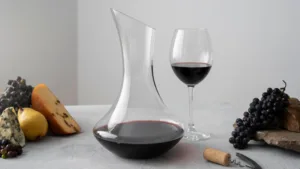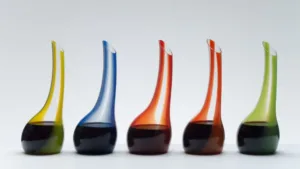You uncork a bottle, pour a glass, and take a sip—only to find the wine feels tight, muted, or gritty and slightly bitter. Decanting wines is something that isn’t a mandate for all wines, but certain wines benefit greatly from this process.
Decanting is more than just a fancy ritual; it’s a simple, powerful technique that can transform your wine from good to exceptional in just a few minutes. Whether you’re pouring a bold red, an aged vintage, or even a young red wine straight off the shelf, here’s decanting can elevate your entire drinking experience.
Table of Contents
ToggleWhat Is Decanting?

Decanting is the process of pouring wine from its bottle into another vessel (the decanter) before serving. Primarily, it does two things to a wine:
Aeration – Decanting the wine to mix with air and “breathe,” which opens up its aromas and softens the tannins.
Separation – Removing sediment from older wines that may have settled at the bottom of the bottle.
A designed decanter is not only an effective way to decant your wine it also looks stunning in your home bar and elevates the wine service experience.
Why Should You Decant Wine?
✔️ Removes Sediment
Sediment forms at the bottom of older bottles. While it is a natural process, these sediments give wine a grainy texture and bitter taste. Decanting lets you separate the clear wine from the cloudy bits that gather at the bottom.
✔️ Opens Up Aromas
Wines—especially reds—often need oxygen to release their full aromatic potential. When you decant, the wine’s molecules interact with air, unlocking everything from ripe fruits and florals to earth, spice, and oak.
✔️ Softens Tannins
Young reds like Cabernet Sauvignon, Malbec, or Shiraz can feel sharp or astringent due to tannins. Decanting helps mellow those bold tannins, making the wine smoother and more balanced.
✔️Covert Pouring
If you are pouring a budget wine at large parties and do not want guests to roll their eyes at the label, the best way is to pour your wine in a classy decanter and avoid the scrutiny.
Also Read: Best Wines For Sangria: Summer Special
Should You Decant Every Wine?

Nope, not all wines benefit from decanting. Here’s what you should know:
Bold Reds: Young wines with strong tannins like Cabernet Sauvignon, Malbec, Syrah/Shiraz, Tannat, and Bordeaux blends benefit the most.
Older vintages: If you see sediment formation in any old vintage, you must decant it.
Whites? Sometimes: Rich, oaked whites like Chardonnay or Viognier can also open up with a bit of air, especially if they’ve been aged. However, white wines can quickly lose their delicate aromas if aerated for too long.
Sparkling Wines? Not Really: Champagne and sparkling wines lose their fizz when decanted, so it’s not recommended—unless you’re intentionally softening a very yeasty vintage Champagne.
How Long Should You Decant?
- Young, bold reds (under 5 years) – 30 to 60 minutes
- Medium-bodied reds – 15 to 30 minutes
- Aged wines (8–15+ years) – 10 to 15 minutes (gently!)
- Affordable or tightly closed wines – A vigorous swirl and 20 minutes can make a world of difference
Tip: If you’re short on time, even a quick 5–10 minute decant can significantly improve a wine’s aroma and texture.
Also Read: Best Cabernet Sauvignon under ₹5000
Award-Winning Wines That Benefit from Decanting
Looking to try this out? Here are a few bottles from the Ultimate Drinking Guide 2024 that truly come alive with a little air:
- Montes Alpha Cabernet Sauvignon – Bold Chilean red with layers of cassis, cedar, and mocha
- KRSMA Estates Cabernet Sauvignon – Indian wine with grippy tannins and age-worthy structure
- Bodegas Rutini Malbec – Argentine powerhouse that mellows beautifully after 30 minutes
- Fratelli Sette – A structured Indian red blend that opens up into a layered, elegant sip
How to Decant Like a Pro

✔️ Choose the Right Vessel – Use a decanter with a wide base to increase surface area and airflow for red wines. Use a smaller decanter for white wines to avoid too much aeration.
✔️ Pour Slowly – For older wines, hold the bottle against a source of light, like a candle. Then pour the wine gently into the decanter, keeping a close eye on the level of sediments. Stop before the sediment reaches the neck.
✔️ Let It Breathe – Leave the wine to rest and swirl occasionally.
✔️ Taste Test – Try a sip when you first open the bottle, and again after decanting. You’ll taste the difference.
Looking to invest in a beautiful decanter? Browse premium options from Riedel—globally loved for their craftsmanship and elegant designs. Explore here on AltVibes.
Looking for amazing wine recommendations? Click here to check out more blogs on the India Wines And Spirits Award website.


